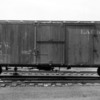I just completed an interesting little project. Looking at vintage photographs of trains from the golden age of steam, I have noticed the variety of wood side cars in their consists. So I decided to try and see if I can make one. I had this Weaver/CMP woodside reefer that I wanted to make into a double sheathed boxcar. I chose this model because they are plentiful and relatively cheap. I also wanted to try painting this car with inexpensive craft paints. Nothing ventured, nothing gained.
Here is the subject car. I had already removed the ladders from the sides and ends...
Here is the prototype I am trying to replicate...
For the conversion process, I removed the roof walk and ground down all the reefer hatches. I removed the end and side stirrups. The reefer door is cast into the shell. I have a choice at this point to model a working boxcar door. I chose to model the door closed. It was good enough for the original car so it thought it was good enough for this conversion. Therefore I ground down all the door hardware flush with the car sides. Referring to my prototype photo, I wanted to have a similar door. The door I chose also came from a Weaver outside braced boxcar. I acquired one from Ebay and used it as a template for scratching building my own. The door Hardware came from Grandt Line. With the door completed I glued it onto the car sides.
I filled in the ladders holes with styrene rod an sanded them flush with car sides. I added Tichy group grab irons to the sides and ends and Tichy group stirrup steps.
Back on the roof, over the sanded down roof hatches I added end roof walks, which I scratch built. Here are modifications prior to painting...
With the changes completed, I washed the model with some soapy water and wiped the surface with Isopropyl alcohol and proceeded to prime priior to painting...
On to paint. For some time I have been wanting to try and paint with cheap craft store paints. For this project, I mixed up my version of freight car red using these paints in a ratio of 2 Parts Brown Iron Oxide to 1 Part cinnamon...
So here it is out of the paint booth...
After a few days drying time a sprayed a light coat of gloss and let that dry for another week.
I've had the decals for quite some time and went on without any problems...
After sealing the decals with a flat finish, weathering was applied. Extra weight was added to the car. Weaver trucks were added and here is the final results...
All in all I don't think it came too terribly bad. It was fun to do and I will being doing a few more of these in the future.








